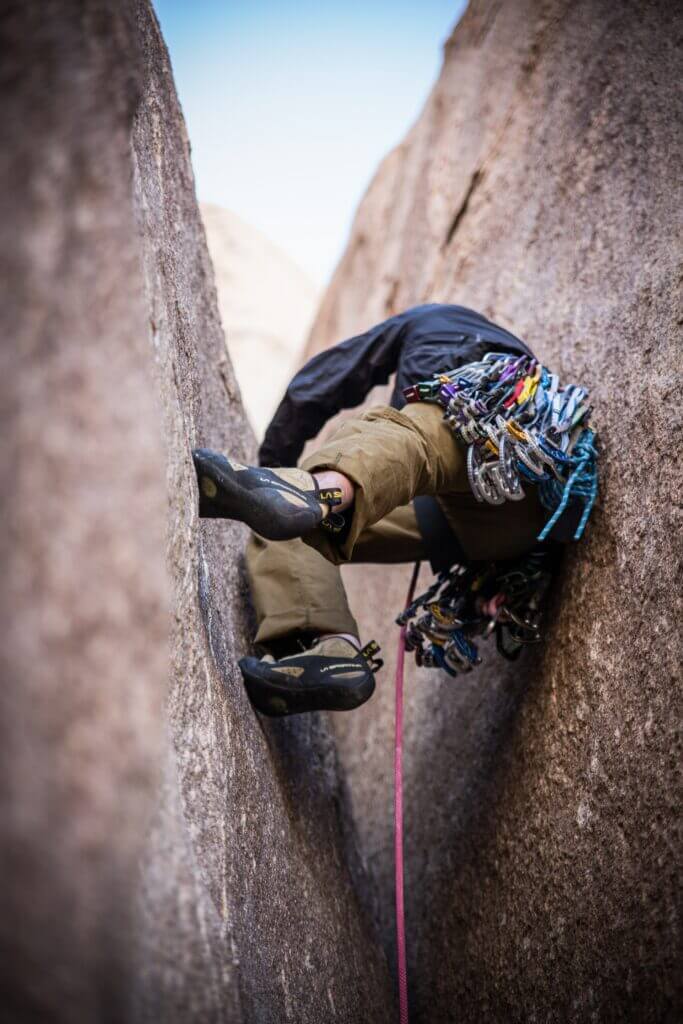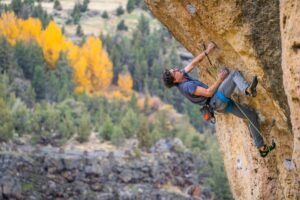Sport and traditional climbing, shortened to trad climbing, are the two most popular climbing styles. Therefore, when a new climber wants to start climbing outside, and they don’t want to begin pebble wrestling (aka bouldering), it’s common to want to compare the two – sport vs. trad climbing.
Realistically, there are similarities between the two styles. For example, they both require similar climbing gear, like a dynamic climbing rope. However, to understand the two disciplines properly, it’s helpful to look at the key differences.
Read on for a brief synopsis of what sport and trad climbing are all about. And for eight critical differences between the two.
Sport vs Trad Climbing
Sport climbing is a younger style of rock climbing where the climber ascends a rock face protecting themselves by clipping their rope into pre-drilled bolts along the way. When they reach the top, they clip into pre-drilled anchors and can be lowered by their belayer or belay their second if multi-pitching.
In comparison, trad climbing is an older style of rock climbing where the climber ascends a rock face protecting themselves by clipping their rope into removable pieces of protection that they place into cracks in the rock. When they reach the top, they build a trad anchor and can be lowered by their belayer or belay their second.

Sport Climbing vs.Trad: 8 Key Differences
I could talk for hours about the subtleties that differentiate sport climbing from trad. But instead, I’ll share eight key differences.
The Discipline Dictates Where You Can Climb
Due to climbing ethics and rock type, climbing areas typically develop predominately as either an arena for sport climbing or a crag for trad climbing.
In most cases, climbing areas with rock that does not offer much in terms of cracks, pockets, flakes, horns, fissures, and knobs, get bolted and become sport climbing areas.
In comparison, if the rock allows for the placement of reliable traditional protection, and local climbing ethic deems bolts necessary, then the area becomes known as a trad climbing zone.
Sure, nowadays, there is an overlap between the two. But in most cases, your ability to safely climb an area will depend on whether it’s a sport or trad crag and the gear you bring.
Gear and Preparation
Sport climbing and trad climbing require some of the same gear. For example, climbing ropes, helmets, climbing shoes, and a harness are required for both.
However, the gear you use to protect the climb is drastically different. Sport climbing relies on quickdraws attached to pre-drilled bolts to protect the climb. On the other hand, trad climbing requires an additional rack of climbing gear to protect the climb adequately.
Because trad climbing requires more gear, it’s generally understood that preparing for a route is more complex. For sport climbing, you can count the number of bolts and bring the equivalent number of quickdraws.
Reading the Route
This brings us to the next difference– reading the route. Reading a sport climb is all about looking for holds and predicting the sequence of movements that will allow you passage. In addition, reading a sport route involves looking for clipping stances and rest positions.
Reading a trad route is similar. However, one distinct difference is reading the route for protection opportunities. You need to assess the route and imagine where you will get gear. Then, you prepare the rack you plan to use before leaving the ground.
Understanding Where to Place Your Anchor
Sport climbs, whether single or multi-pitch, have established anchors–usually two bolts with other chains or hardware for clipping in. Some trad routes may have bolted anchors if it’s a particularly “sporty” single-pitch crag or a well-developed multi-pitching area.
But for the most part, trad routes require the climber to construct an anchor using trad gear. Building anchor requires an extra set of knowledge and skill to do safely. For example, understanding where to place the anchor and how to make it bomb-proof.
Availability to Climb Indoor vs. Outdoor
One reason sport climbing has become so popular since its creation in the 1980s is its accessibility. In particular, because you can sport climb inside.
Learning how to sport climb and train inside climbing gyms has been an incredible boon for the sport climbing discipline.
In comparison, trad climbing is generally understood as an outdoor sport. Yes, some gyms nowadays have artificial cracks, but those are climbed using a top rope and primarily for practising crack climbing technique and not for placing gear.

Your Risk Assessment is Different
Both climbing styles are inherently dangerous and not safe. To perform safely in either climbing discipline, you must assess risk and make critical decisions to mitigate risk. Some of your choices could even be the difference between life and death.
However, it is generally understood that sport climbing is less risky than trad climbing. This is because strategically placed bolts make the climber less exposed to a big fall.
On the other hand, how exposed a climber is to a significant fall while trad climbing is based on the availability of gear placements, the quality of the natural features of the rock, and their ability to place reliable gear that will catch them.
Therefore, the risk assessment a climber performs while trad climbing is generally understood to be significantly more complex and nuanced than the decision-making a sport climber performs as they navigate the route.
Climbing Style Use Different Muscles
The climbing techniques for sport climbing and trad climbing can be very distinct. For example, sport climbing is characterized by face climbing, whereas trad climbing is characterized by crack climbing. Again, there will be an overlap between these two techniques, but the general distinction remains somewhat true.
The pump you get from hard face climbing is different from trad climbing. Crimping on small edges, pulling on pockets, and knee barring in roofs uses different muscles and gives an entire body workout.
On the other hand, hand-jamming, using off-width technique, foot-jamming, and scaling cracks provide you with a completely different sensation and workout. In this regard, no climbing style is better than the other. They’re just different.
Impact on the Climbing Environment
Sport climbing permanently alters the climbing environment more than trad climbing. For a sport climb to be safe, it requires drilling holes and equipping the rock with bolts and bolt hangers. Anchors need to be installed at the top of the climb, also.
In comparison, trad climbers bring and take everything they’ll need when they arrive to do a climb and when they leave.
Back in the day, this wasn’t always true because trad climbers were hammering in equipment like pitons. But nowadays, since trad gear has dramatically improved, the only thing left behind on a trad route should be chalk.
The reality of trad’s limited impact and the adventurousness of leaving the ground with a finite amount of protective equipment is why trad climbers love the discipline so profoundly.


